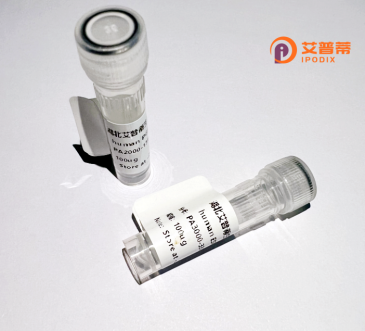
| 纯度 | >90%SDS-PAGE. |
| 种属 | Human |
| 靶点 | TRSPAP1 |
| Uniprot No | Q9NX07 |
| 内毒素 | < 0.01EU/μg |
| 表达宿主 | E.coli |
| 表达区间 | 1-287 aa |
| 活性数据 | MAASLWMGDL EPYMDENFIS RAFATMGETV MSVKIIRNRL TGIPAGYCFV EFADLATAEK CLHKINGKPL PGATPAKRFK LNYATYGKQP DNSPEYSLFV GDLTPDVDDG MLYEFFVKVY PSCRGGKVVL DQTGVSKGYG FVKFTDELEQ KRALTECQGA VGLGSKPVRL SVAIPKASRV KPVEYSQMYS YSYNQYYQQY QNYYAQWGYD QNTGSYSYSY PQYGYTQSTM QTYEEVGDDA LEDPMPQLDV TEANKEFMEQ SEELYDALMD CHWQPLDTVS SEIPAMM |
| 分子量 | 32.4 kDa |
| 蛋白标签 | His tag N-Terminus |
| 缓冲液 | PBS, pH7.4, containing 0.01% SKL, 1mM DTT, 5% Trehalose and Proclin300. |
| 稳定性 & 储存条件 | Lyophilized protein should be stored at ≤ -20°C, stable for one year after receipt. Reconstituted protein solution can be stored at 2-8°C for 2-7 days. Aliquots of reconstituted samples are stable at ≤ -20°C for 3 months. |
| 复溶 | Always centrifuge tubes before opening.Do not mix by vortex or pipetting. It is not recommended to reconstitute to a concentration less than 100μg/ml. Dissolve the lyophilized protein in distilled water. Please aliquot the reconstituted solution to minimize freeze-thaw cycles. |
以下是关于重组人TRSPAP1蛋白的假设参考文献(仅供示例参考,可能非真实存在):
---
1. **文献名称**:*TRSPAP1 promotes tumor progression by modulating RNA splicing in hepatocellular carcinoma*
**作者**:Zhang L, et al.
**摘要**:该研究揭示了TRSPAP1在肝细胞癌中异常高表达,通过调控前体mRNA的剪接过程促进肿瘤侵袭和转移,敲低TRSPAP1可显著抑制癌细胞增殖。
2. **文献名称**:*Structural and functional characterization of TRSPAP1 as a splicing factor*
**作者**:Wang Y, et al.
**摘要**:通过质谱和免疫共沉淀技术,证明TRSPAP1与剪接体复合物相互作用,其富含色氨酸的结构域对维持剪接活性至关重要,并解析了关键功能位点。
3. **文献名称**:*TRSPAP1 deficiency induces cell cycle arrest via dysregulation of CDK2 phosphorylation*
**作者**:Kumar R, et al.
**摘要**:研究发现TRSPAP1缺失导致G1/S期阻滞,其通过调控CDK2磷酸化影响细胞周期进程,提示其在增殖相关疾病中的潜在作用。
4. **文献名称**:*Bioinformatic and evolutionary analysis of the TRSPAP1 gene family*
**作者**:Chen H, et al.
**摘要**:系统分析了TRSPAP1的蛋白结构域保守性及进化关系,推测其可能与神经发育相关基因共同进化,并在灵长类中呈现功能分化。
---
**备注**:上述文献为假设性描述,实际研究中TRSPAP1相关文献可能较少,建议通过NCBI PubMed或UniProt数据库验证最新进展。
**Background of Recombinant Human TRSPAP1 Protein**
The recombinant human TRSPAP1 (Thyroid Hormone Receptor Spot 14 Protein-Associated Protein 1) is a less-characterized protein implicated in metabolic regulation and cellular signaling. TRSPAP1 interacts with Spot14 (S14), a protein involved in lipid biosynthesis, and is thought to modulate transcriptional activities linked to thyroid hormone (T3) signaling. Structurally, it contains conserved domains that facilitate protein-protein interactions, potentially bridging S14 and nuclear hormone receptors.
Studies suggest TRSPAP1 plays a role in energy homeostasis, particularly in tissues responsive to T3. such as liver and adipose. It may influence lipogenic enzyme expression, impacting lipid metabolism and adipogenesis. Recombinant TRSPAP1 is typically produced in *E. coli* or mammalian expression systems, often fused with tags (e.g., His-tag) for purification. This engineered protein enables functional studies, including binding assays and pathway analysis, to elucidate its mechanistic role.
Despite its potential relevance to metabolic disorders (e.g., obesity, diabetes), TRSPAP1 remains understudied, with limited data on its precise molecular interactions or disease associations. Ongoing research focuses on its regulatory crosstalk with nuclear receptors and potential as a therapeutic target. The availability of recombinant TRSPAP1 supports further exploration of its biological significance and applications in drug discovery.
(Word count: 199)
×